The normally faint quasar CTA 102, once thought to harbor an advanced civilization and made famous in a 1967 song by the Byrds, is currently bright enough to see in an 8-inch telescope.
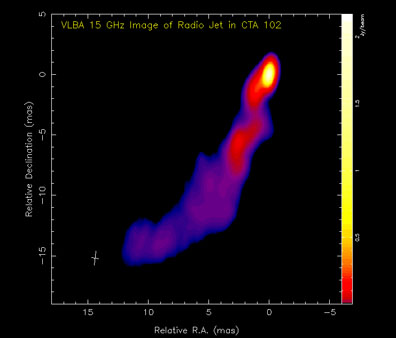
MOJAVE program, M. Lister (Purdue University) et al.
In the history of SETI, the Search for Extraterrestrial Intelligence, there have been two great false alarms. The first occurred in 1963 when powerful radio waves were detected from the source CTA 102 in Pegasus. Followup observations in 1965 showed that the source's radio emission was varying, prompting then-Soviet astronomer Gennady Sholomitskii to declare that an advanced civilization was behind the transmissions.
Not long after, observations made with the 200-inch Hale Telescope identified the fluctuating object as a quasar, a supermassive black hole at the center of a remote galaxy.
The second false alarm is associated with the discovery of the first pulsar by Jocelyn Bell in 1967. The steady "thunk" of radio signals every 1.33 seconds earned this object the nickname LGM-1, short for "little green men." Pulsars are rapidly rotating neutron stars that beam a narrow beacon of radio waves in our direction every rotation. Some rotate hundreds of times a second and sound like buzzing bees when the signals are converted into sound.
But back to CTA 102. The worldwide buzz about an alien origin for the quasar was still in the air in 1967 when the American rock band the Byrds recorded the song "C.T.A. 102" on their Younger Than Yesterday LP. The lyrics (below) offer a hopeful message, and the upbeat tune ends with a fun twist — be sure to give it a listen. This may be the only song ever recorded about a quasar!
Year over year receiving you
Signals tell us that you're there
We can hear them loud and clear
We just want to let you know
That we're ready for to go
Out into the universe
We don't care who's been there first
On a radio telescope
Science tells us that there's hope
Life on other planets might exist
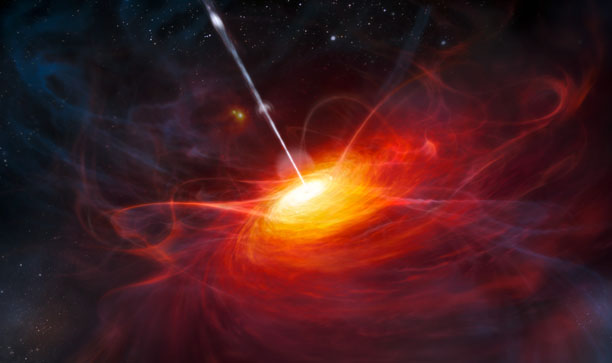
ESO / M. Kornmesser
Like many quasars, CTA 102 is subject to variations in its light depending on what the supermassive black hole is consuming and how it goes down. Powerful gravitational and frictional forces cause material in an accretion disk around the hole to radiate tremendous amounts of energy, primarily in X-ray wavelengths, but also in radio, visual, and other forms of light, before it's sucked into the black hole and disappears forever.
Normally, CTA 102 glows weakly at around magnitude +17, a terrifically tough target for most amateur astronomers. But in early November it underwent a dramatic outburst in brightness. I tracked it down Monday night (November 21st) in my 15-inch scope at magnitude +13.8! That's well within range of an 8-inch telescope.
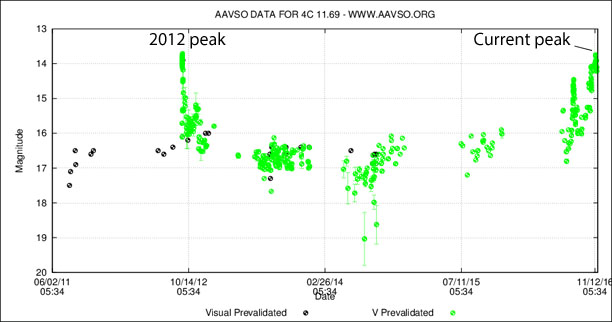
AAVSO
Thomas Balonek (Colgate University) and team reported in Astronomer's Telegram #9732, that "to our knowledge, this is the brightest level reported in over 40 years of optical monitoring by several groups, including the well-documented optical outburst in 2012."
Others have recorded rapid variations in the quasar's light of up to 0.4 magnitude in the span of just two hours. With the Moon out of the sky and the target on the meridian at nightfall this month and early next, I encourage to feast your eyes on this rare event.
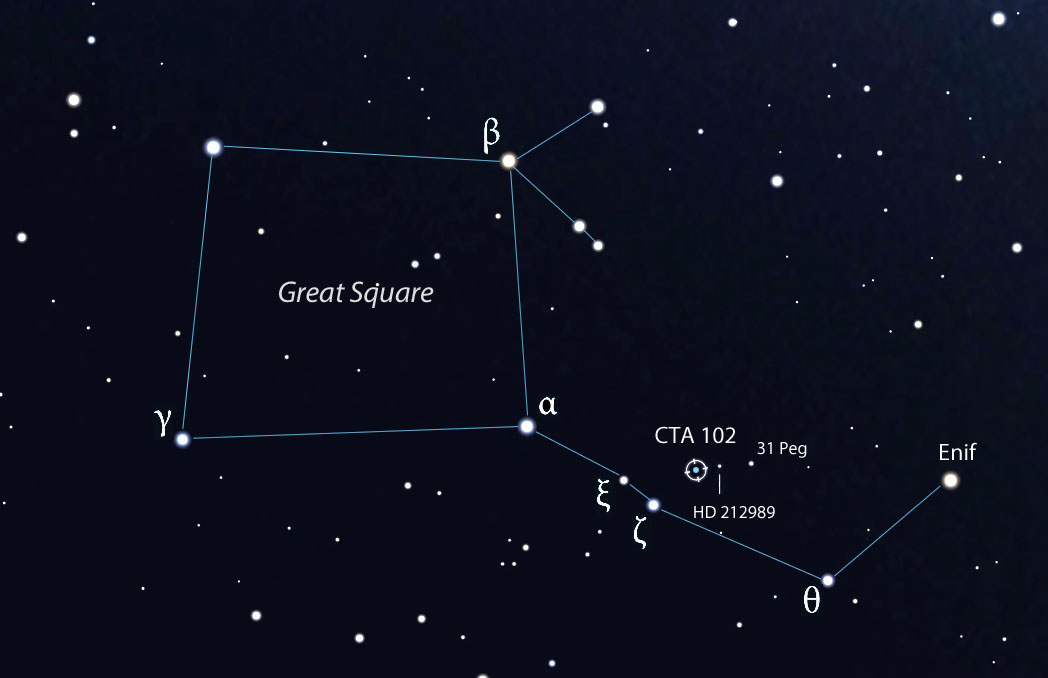
Map: Bob King, Source: Stellarium
You'd be wise to start your observing session with CTA 102, making an estimate of its magnitude using the provided chart or download and print this sequence of AAVSO charts: B (wide field), D (narrower view) and E (close in). Note that the alternate name, 4C 11.69, is used by the AAVSO. Return an hour or two later, before finishing up for the night, and make another brightness estimate. Given the quasar's erratic behavior, you might just witness it in the act of choking on its food!
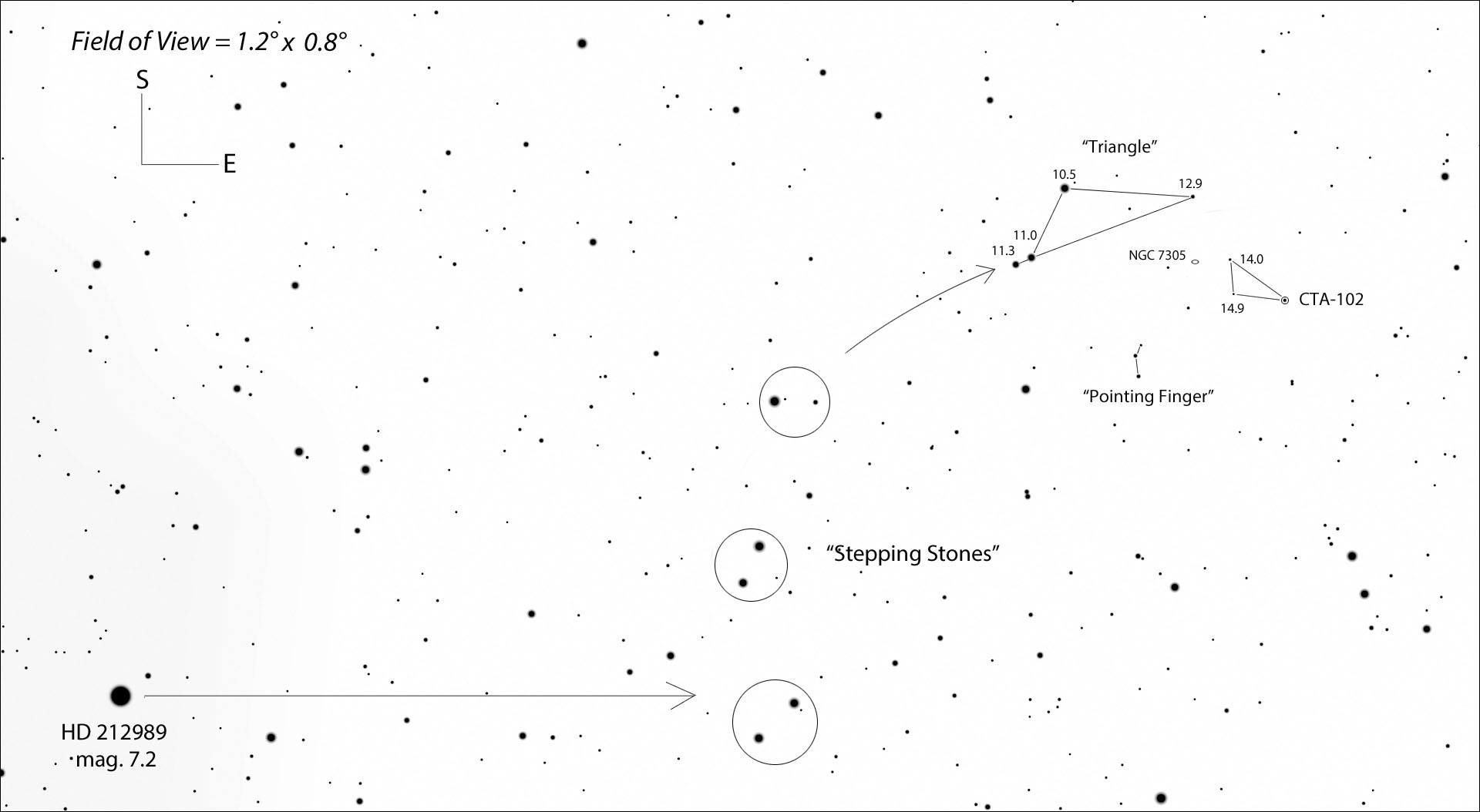
Map: Bob King, Source: Stellarium
The "CTA 102" comes from the 102nd entry in the Caltech Survey, part A, a very early radio survey done at Owens Valley California, according to Matthew Lister, Professor of Physics and Astronomy at Purdue, who examined the quasar with the Very Long Baseline Array (VLBA). At 8 billion light-years distant, it might be the easiest, most remote object you'll ever see.
But be sure to look quick! There's no telling how long this outburst may last. Using the maps, star-hop to the erstwhile alien beacon with an 8-inch or larger telescope. Once you've arrived in the general vicinity with low magnification (50×-75×) and identified the brighter star patterns, up the magnification to 150x to pinpoint the quasar then increase the power to 200×. High magnification darkens the sky for a clearer, higher contrast view of those ancient photons.
The Byrds may have flown, but CTA 102 remains to thrill the visual observer with raw power and visions of long, long ago.
Resources:
- Research into CTA 102
- Track the quasar's ups and downs at the AAVSO website. In the Pick a Star box, use 4C 11.69 and click the Recent Observations link.
 38
38








Comments
Tom Hoffelder
November 24, 2016 at 8:51 am
Wow, a chance to quadruple the age of the oldest photons that have sent signals through my optic nerve! Awesome! Thanks for the article!
You must be logged in to post a comment.
Bob KingPost Author
November 24, 2016 at 11:22 am
You're welcome! Go for it, rocksnstars, and come back to share your observation. Clear skies!
You must be logged in to post a comment.
November 25, 2016 at 4:42 pm
Yeah but according to relativity time stands still at the speed of light. So the photons are no older than ones from your reading lamp. 🙂
You must be logged in to post a comment.
ErnieOstuno
November 24, 2016 at 11:39 pm
The correct declination is +11° 43′ 51″. It can be found on the sky-map dot org website. If it's clear the next few nights I will try and see it.
You must be logged in to post a comment.
Bob KingPost Author
November 24, 2016 at 11:49 pm
Good catch, Ernie. I inadvertently reversed the "4" and "3". Now correct. Clear skies!
You must be logged in to post a comment.
Bryan
November 25, 2016 at 2:50 pm
If any of you go looking for CTA-102, the Dec coordinate listed in the Map of Pegasus wide field caption is incorrect.
It should be Dec +11 43’ 51”. The detailed sky chart with the ‘pointing fingers’ and NGC 7305 will also get you to the right place.
You must be logged in to post a comment.
Bob KingPost Author
November 25, 2016 at 3:02 pm
Hi Bryan,
The correct declination is indeed shown. It is: +11° 43′ 51″.
You must be logged in to post a comment.
Tom-Reiland
November 25, 2016 at 6:17 pm
I went to the AAVSO page and the chart they have of 4C 11.69 does not match with anything on your chart or the printout I made using the Stsci webpage. The Stsci image shows CTA 102 (4C 11.69) as a fuzzy double in the location on your chart. The galaxy NGC 7305 is listed at 15 mag with four faint stars around it and it's just West of CTA 102 and very slightly South of it. Go to this page for an image of the field: http://archive.stsci.edu/cgi-bin/dss_form
You must be logged in to post a comment.
Tom-Reiland
November 27, 2016 at 9:30 pm
First off, I was able to locate CTA 102 tonight. I'm not sure of the magnitude, but I estimate between 13.7 and 14 mag. Two corrections to my previous post: 1) The AAVSO chart is accurate. I was comparing it to your chart and to my printout from the Stsci page. They appear different because of the field of view aren't the same and I was approaching CTA 102 from another direction. 2) It is a very faint star like object on the Stsci page and not the double that might be star and galaxy close together that I mentioned. I couldn't see them at all. I was using the 21" scope at Wagman Observatory. I used 282X to see it easily and just barely at 130X Thanks for the info, Bob.
You must be logged in to post a comment.
Bob KingPost Author
November 28, 2016 at 12:19 am
Hi Tom,
Thanks for sharing your brightness estimate. I haven't been able to get out in nearly a week because of clouds. Yes, the fields of view of the AAVSO charts are a little different from mine. Each of the AAVSO links offers a successively more zoomed-in view of the CTA 102 field. As for that galaxy, I could see it here in my 15-inch, but it was faint. Averted vision required!
You must be logged in to post a comment.
November 28, 2016 at 12:26 pm
I observed the quasar on Saturday evening (Nov. 26) with an 18-inch reflector and estimated the magnitude to be about +13.6. It was stellar and easily seen at both 146x and 295x.
You must be logged in to post a comment.
Tom-Reiland
November 28, 2016 at 5:26 pm
Here's an object that is listed at 9 Billion LY away. PG 1634+706. It's listed at 14.9 magnitude. I'll give it a shot in the Spring.
You must be logged in to post a comment.
Bob KingPost Author
November 28, 2016 at 9:51 pm
Tom,
A billion here, a billion there 😉 I know there's another, the farthest I've heard of for amateur viewing, that's about 10 billion light years away. Can't recall the name at the moment though.
You must be logged in to post a comment.
Bob KingPost Author
November 28, 2016 at 9:48 pm
Hi Mark and thanks! That tells us that this extraordinary outburst is as bright as this object's ever been recorded.
You must be logged in to post a comment.
SNH
November 30, 2016 at 5:03 pm
Wow! Thanks a lot for the notification on quasar CTA 102’s sharp jump in brightness, Bob! I hadn't ever known about it because it's not one that Stefan Karge regularly monitors on his excellent Frankfurt Quasar Monitoring website. That being said, I went out and looked at it on the 28th of November at 8:30pm CST and placed it at magnitude +13.1 ( a little brighter than the magnitude +13.2 star and noticeably dimmer than the +12.9 star on the AAVSO star chart). I was even able to see it, along with the magnitude +14.9 star to its W and the galaxy NGC 7305 using only 78x or 132x in my 10-inch SCT. At the magnitude I saw it at, it's the second brightest quasar I've seen (after 3C 273) and the seventh one above magnitude +14.0 that I've logged! The farthest one I’ve seen is PG 1634+706 in Draco at magnitude +14.6 and some 8.8 billion light-years distant. This one’s nearly as far and definitely much brighter, so I hope tons of people get to see it! Timely article and good findercharts. Thanks.
Oh, By the way - If you happen to remember than quasar you mentioned that's about 10 billion light-years away, please let me know! If it gets or stays brighter than +15.5 (and gets high enough), I at least got a chance of seeing it! See ya.
You must be logged in to post a comment.
Bob KingPost Author
December 1, 2016 at 10:29 am
SNH,
Fantastic. It's been brightening and outbursting even more the past week. Tom comments below that other AAVSO members have recorded mag. 12.6 in recent nights. That's incredible - that would put the quasar at its brightest ever.
You must be logged in to post a comment.
Tom-Reiland
December 1, 2016 at 2:27 am
I just checked the AAVSO webpage for recent magnitude estimates of the quasar CTA 102. As of Tuesday night it was up to 12.6 mag. This is observable in a 6 inch scope under ideal conditions. Wow!
You must be logged in to post a comment.
Bob KingPost Author
December 1, 2016 at 10:30 am
Thanks Tom - your report of the new mags. makes me even more eager for clear skies to check on CTA 102 again. Might finally get a chance tonight.
You must be logged in to post a comment.
Håkon Dahle
December 1, 2016 at 4:34 pm
I estimated it to be of visual magnitude 11.8 earlier tonight, a brightness surge of 0.8 magnitudes since I observed it last night. Now, three hours later, it has dropped by 0.3 magnitudes to magnitude 12.1. It's pretty amazing to follow this remarkable object!
You must be logged in to post a comment.
Bob KingPost Author
December 1, 2016 at 7:17 pm
Thank you, Håkon. You're making me - and others who have been stuck under clouds for a while - very jealous!
You must be logged in to post a comment.
Tom-Reiland
December 1, 2016 at 4:45 pm
Today's estimate on the AAVSO page lists it at 11.8. That means it will be cloudy in Western Pennsylvania for several nights or more.
You must be logged in to post a comment.
Bob KingPost Author
December 1, 2016 at 7:19 pm
Tom,
I just checked there, too: 11.8, 12.1, etc. estimates. Simply amazing - an 8 million light year distant quasar is now visible in a 6-inch and even a 4.5-inch scope in dark skies.
You must be logged in to post a comment.
Harro-Treur
December 2, 2016 at 5:02 pm
The far-away object you were wondering about: Quasar S5 0014+81. It is located near Polaris, although at a distance of more than 10 billion light-years!
Mag 16,5. So quite a challenge.
Here a small article about my detection in 2009.
http://www.astroforum.nl/forum/visueel-waarnemen/schetsen/21148-quasar-s5-0014-81-het-verst-verwijderde-visuele-vlekje
You must be logged in to post a comment.
Bob KingPost Author
December 3, 2016 at 1:49 am
Dear Harro - it was possibly that, but I was thinking it was a quasar in Andromeda. I've been busy and haven't had time to check my charts but will this weekend and get back to you and others. In the meantime thank you for S6 0014+81!
You must be logged in to post a comment.
Håkon Dahle
December 15, 2016 at 7:38 pm
The latest photometry reported to AAVSO indicates a re-brightening of CTA 102, to V=11.8 at December 15.71 UT.
You must be logged in to post a comment.
Bob KingPost Author
December 15, 2016 at 8:34 pm
Thank you, Håkon for the update. I believe that ties another recent 11.8 magnitude estimate. The quasar continues to make history!
You must be logged in to post a comment.
Tom-Reiland
December 15, 2016 at 8:15 pm
I just came in from observing CTA 102 from my backyard using my 16" Dob at 91X. I estimated it at 11.5 mag using the 11.7 mag star plotted near it on the AAVSO chart. It was easy to see from my light polluted neighborhood about 8 miles north of Pittsburgh, Pa. I'm glad that I got to see it at what might be it's brightest so far. Not a comfortable night for observing. 10 degrees F and windy, though the wind seems to have died down.
You must be logged in to post a comment.
Bob KingPost Author
December 15, 2016 at 8:35 pm
Hi Tom,
You suffered for your quasar! That's bright! Thank you for sharing your observation.
You must be logged in to post a comment.
Tom-Reiland
December 16, 2016 at 4:10 pm
Apparently, I was the only one in the USA, especially in the very cold East to venture out to check on CTA 102. I see no reports from our area on the AAVSO webpage of magnitude estimates, just a big gap between the European observers.
You must be logged in to post a comment.
Bob KingPost Author
December 18, 2016 at 9:26 am
Tom,
I was able to check it last night, and it had faded to mag. 13.2. Of course tonight, it may just as likely return to 11.5!
You must be logged in to post a comment.
Tom-Reiland
December 20, 2016 at 1:31 am
Bob,
I want to thank you for getting me and my friends involved with observing this fascinating object. It's been so much fun checking the reports on AAVSO.org and observing it, even though the weather and the Moon only gave us three opportunities to view it so far out of 23 nights here. Tonight I estimated it at 12.3 mag. Its brightness was halfway between the 12.9 and 11.7 mag stars on the AAVSO chart. I observed it with the 21" reflector at Wagman Observatory at 130X. Time to thaw out. It was another chilly night, but it only got sown to 15 degrees F.
You must be logged in to post a comment.
Michel Deconinck
December 23, 2016 at 5:40 am
Thank you Bob for this very interesting report about this so strange object.
Your reports are always so interesting.
As mensioned by Tom here before, in Europe we have good conditions for the following of this blazar. From the reception of the AAVSO's alert I made already 19 estimations in 11 different nights. I post a sketch of one of my observation in the S&T photo gallery.
The show is still running, yesterday my last visual estimation was close to 12.0.
Michel
You must be logged in to post a comment.
Bob KingPost Author
December 23, 2016 at 5:42 pm
Aquarellia,
Thank you, and it's nice to hear "the show is still running." I only wish I could catch CTA 102 at mag. 12. I've only managed 13.2 ... but I'm not complaining!
You must be logged in to post a comment.
Tom-Reiland
December 27, 2016 at 11:00 pm
I headed to Wagman Observatory this evening to get another look at CTA 102. Once again, WOW! I estimated it at 11.3 to 11.4 mag through the 21" reflector at 130X. It was easily brighter than the 11.7 mag reference star near it. Too bad the AAVSO chart didn't list magnitudes for 11 mag stars to help make an estimate. I guess no one expected it to get this bright. This is a very special celestial happening. Thanks again for sharing info about it.
You must be logged in to post a comment.
Tom-Reiland
December 29, 2016 at 6:41 am
I was able to get one more observation of CTA 102 last night before the bad weather moves in and the Moon starts to interfere with Deep Sky observing. It was slightly brighter than the previous night. It is 11.2 to 11.3, probably closer to 11.2 mag. I just saw two visual observations listed on the AAVSO page almost exactly the same time that I observed, listing it at 11.15 and 11.2. I was able to get three more AAAP members to see it and they remarked at how easy it is to see now. It may only look like a dim star amongst the other faint objects, but what's going on there makes it so exciting to see. Happy New Year, Bob and wishing for many clear skies in 2017 where you live and observe!
You must be logged in to post a comment.
Bob KingPost Author
December 29, 2016 at 10:18 am
Hi Tom,
I've been watching those AAVSO estimates and still can't believe it -- 11.2 mag. That's a snap for a 4-inch! Thanks for all your reports and have a fun New Year's Eve night and a great 2017.
You must be logged in to post a comment.
Michel Deconinck
December 31, 2016 at 1:15 am
Hi Bob,
Hi Tom, indeed your estimations are very close to mine on the AAVSO curve, anyway there is a new map for estimation showing magnitude as brillant as 10.5.
I wish you all a clear sky during the new year 2017
Michel
You must be logged in to post a comment.
Michel Deconinck
December 31, 2016 at 1:18 am
You are right Bob, yesterday I was able to detect the blazar with à Vixen 5" bino, magnification 40x only
Michel
You must be logged in to post a comment.
You must be logged in to post a comment.